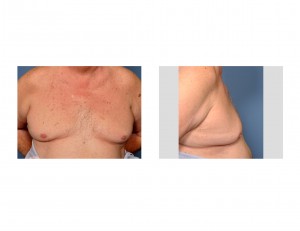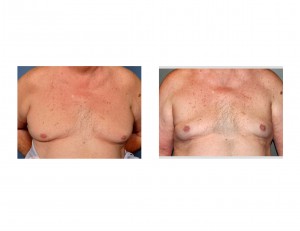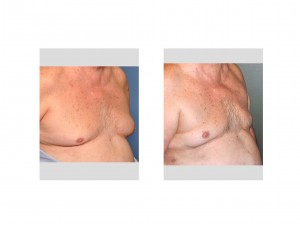Background:Gynecomastia is a well known condition that largely affects the teenage and younger male. Male breast enlargement is most likely to be affected during the hormonal changes that occur during and after puberty. On the opposite side of puberty, the andropause era of men may cause gynecomastia as testosterone levels drop and numerous drugs for medical conditions may cause it. This is sometimes unflatteringly referred to as ‘senile gynecomastia’. But this is an inaccurate term and is better referred to as older gynecomastia to differentiate it from juvenile gynecomastia.
Older gynecomastia is different than that which appears in younger men in numerous ways. The amount of breast enlargement is often less and more diffuse in consistency. But the biggest difference is in the shape and amount of chest skin. The chest skin is more loose and sags and the nipple position is much lower than normal. Often the nipple may be close to or at the level of the inframammary fold. The skin also has lost much of its native elasticity. The lax skin and the droopy shape of the chest is often far more significant than the volume of breast tissue.
Because of differing tissue characteristics, the older gynecomastia male patient requires greater consideration of the extra skin problem and the position of the nipple. Ideally procedures such as horizontal excision of overhanging skin and free nipple grafting or liposuction with periareolar nipple lifts may be needed. But many men do not want the scars that result from these procedures and prefer liposuction alone to avoid this concern.



Smartlipo offers an effective treatment for gynecomastias in older men but the amount of skin retraction is limited. It does not always result in an ideal chest result from a skin redraping standpoint but that is the trade-off for avoiding visible scars.
Case Highlights:
1) Gynecomastia in older men is different than in younger men and teenagers. The primary problem is soft tissue sagging that has lost much of its elasticity. The amount of breast enlargement is usually less significant than the size of the overlying skin problem.
2) Ideal older male chest contouring addresses the sagging skin through nipple repositioning and skin tightening/lifts. The scars that result from these procedures, however, may be unappealing to some men.
3) Liposuction of older gynecomastia provides improvement but not an ideal result as there is too much skin. Smartlipo aids the skin retraction process and is helpful in this form of gynecomastia treatment.
Dr. Barry Eppley
Indianapolis, Indiana



